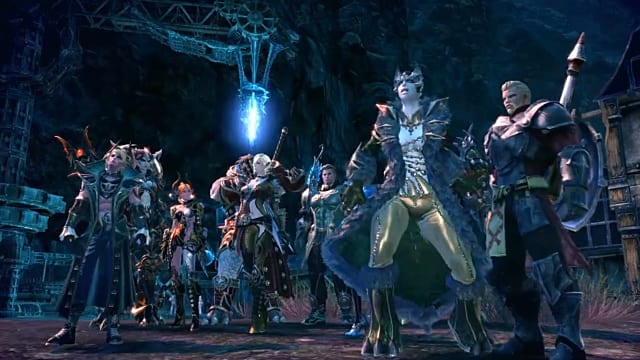Meeting your recruitment goals in a guild or community group is kind of the same thing. On the one hand, it’s great! You’re not chasing after new people any longer, holding interviews, trying to swell your ranks. Your ranks are right about where you want them to be! But at the same time, you spend so much time and energy on trying to build a solid base that when you do, you’re not sure exactly where to go with it. What do you do when you’re in a good place?
The answer, of course, is “a lot of things.” But part of what you have to do is get out of the mindset that you’re always recruiting.
Yes, you can stop recruiting
The worst thing you can do is make a group bigger than it should be. I’ve discussed in previous columns the importance of making sure you have a guild at the right size, but there’s a certain impulse to just sort of keep expanding beyond that. Bigger is always better, right?
No. It’s not. It’s not better. When you have reached the right size, stop. The ability to say that you’re not looking for more players exists for a reason.
Continuing to recruit when you have the population you want means that you are embracing a cycle of always growing rather than reinforcing what’s already there. I understand that you might be wondering what you should do with your existing recruitment officers/members/whatever, but the point is that you can stop.
Admitting it’s time to stop is the first step toward stopping.
Internal recruitment
So let’s talk about those recruiters. They don’t have work to do now, right? Wrong.
Good leadership doesn’t stop when you have a large enough pool of people. Once you’re no longer trying to fill up your numbers, that means it’s time to start recruiting internally. It’s time to stop making this a group which X number of people belong to and time to start making it a single cohesive group. Internal recruitment is all about turning the people who are already members into people who want to be members, smoothing out differences, and generally fostering a sense of cohesive identity.
For example - let’s say you have your guild in World of Warcraft, and your purposes have it set at 25 members as just the right number. My first suggestion would be to start pulling together dungeon groups out of your ranks and run them together. Get everyone accustomed to one another’s playstyle and get the ball rolling for the people in the guild to form groups with one another by default, welcoming rather than resenting one another’s company.
I’m not saying that everyone is necessarily playing at the same level or equally competent, but if you want your group in the long-term to be more than just a handful of people farting around until they leave, you want people to be on the same page. That’s more than a guild tag; that’s a sense of reliability and trust.
One of the better small guilds I’ve been a part of had “member theme weeks” running for a while. The idea was that members who had been there for a while would be the “officer” for a given week, organizing events that people could take part in based on what that member was interested in. The tacit understanding was that we’d all jump in on Steve’s week and work with him, and Steve would in turn come along with us. Sure, Steve might not be as interested in PvP, but it helped him understand how his guildmates played and enjoyed the game.
Guild-oriented events don’t even have to be in the game. Netflix is a thing now; organize a group watch of a film that several of you might enjoy. Form a spinoff group for hanging out on Skype. Give players a spot to rally around, and make sure that you’re building a place where everyone wants to be present on the regular.
Forming connections
Your guild is just the size you want it to be, but you also know that there are people who are going to want to leave eventually. And so a reasonable thing to do… is still not recruit, but focus on finding other places where players can go.
The reality is that there are other guilds out there, there are always going to be other guilds out there, and those guilds are going to have different foci and goals. Sometimes a member might be a better fit there than in your guild. By providing a link between guilds, rather than creating a sense of competition over players, you’re fostering a free exchange of members and ideas. If Steve would be happier there, you can part as friends rather than coldly shutting the door.
And maybe there’s someone else who would fit better in your guild in the process, to boot.
Forming connections with other guilds has other benefits, as well - it makes sure that you can communicate about issues that may affect everyone, such as particular problem members bouncing from guild to guild or coordinating on large-scale events. It can also be mutually beneficial in other ways. Guild A is all about progression and doesn’t have anyone who likes crafting; Guild B loves crafting but can’t get all of the progression-oriented materials. The two can work together without having to sacrifice individual identity.
Speaking of which…
Reinforce your identity
Group cohesion is what’s going to keep your members in place and happy over the long term. Identity is what’s going to matter to the guild when those members are moving on and the game is changing.
Identity is a nebulous concept, and it refers to a lot of things. It refers to rules of behavior and your reputation for same. It refers to your guild’s branding and image. It refers to who your group is seen as being. It’s the sort of thing that sports teams spend a lot of time thinking about, and you might think that it’s pointless, but it has a pretty massive impact when you realize that the perceptions of those same teams are based on the team identity.
Do you want your guild to be seen as a good group? Help those not in your guild. Be friendly. Have open events with non-members. Be welcoming. If someone reports a member for behaving poorly, take that seriously. Place a high emphasis on creating an impression that you want to emulate.
This is hard work, and it involves a lot of examination of your guild’s behavior in dealing with non-members. That’s why this is the time to really focus on it. When you’re recruiting actively, you’re taking in lots of people. Once you’ve got an actual base to work with, you can pay more attention to the actual impression that your group leaves in the heads of others.
After all - eventually, you are likely going to need to add more people into the group. Would you rather recruit more people with a reputation of being a gang of jerks or when everyone knows you’re a guild of class acts?




